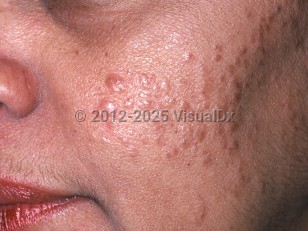Osteoma cutis in Child
Alerts and Notices
Important News & Links
Synopsis

Osteoma cutis is a condition of true bone formation within the skin. It may be primary, with no preceding lesions; secondary (metastatic), when associated with parathyroid metabolism abnormalities; or dystrophic, when ossification occurs in a site of an inflammatory process.
There are four genetic disorders associated with primary osteoma cutis. These are fibrodysplasia ossificans progressiva, progressive osseous heteroplasia, Albright hereditary osteodystrophy, and widespread or single platelike osteoma cutis. In addition, primary osteoma cutis may occur as an idiopathic event, usually later in life, as a solitary osteoma.
Multiple miliary osteomas may occur later in life as well, usually in females. These tend to occur in people with a history of acne, and lesions tend to occur within scars. Pigmented cutaneous osteomas may develop in patients treated with tetracycline or minocycline for acne. There is no correlation between severity of acne scarring and the occurrence of osteomas.
Cutaneous bone formation may occur within basal cell carcinomas, cutaneous mixed tumors, intradermal nevi, scars, venous stasis, folliculitis ulerythematosa reticulata, scleroderma, and dermatomyositis. In pilomatricomas (pilomatrixomas), ossification rarely occurs although calcification is common.
For disorders in which dystrophic calcification occurs (such as the CREST form of scleroderma and juvenile dermatomyositis), see calcinosis cutis.
There are four genetic disorders associated with primary osteoma cutis. These are fibrodysplasia ossificans progressiva, progressive osseous heteroplasia, Albright hereditary osteodystrophy, and widespread or single platelike osteoma cutis. In addition, primary osteoma cutis may occur as an idiopathic event, usually later in life, as a solitary osteoma.
Multiple miliary osteomas may occur later in life as well, usually in females. These tend to occur in people with a history of acne, and lesions tend to occur within scars. Pigmented cutaneous osteomas may develop in patients treated with tetracycline or minocycline for acne. There is no correlation between severity of acne scarring and the occurrence of osteomas.
Cutaneous bone formation may occur within basal cell carcinomas, cutaneous mixed tumors, intradermal nevi, scars, venous stasis, folliculitis ulerythematosa reticulata, scleroderma, and dermatomyositis. In pilomatricomas (pilomatrixomas), ossification rarely occurs although calcification is common.
For disorders in which dystrophic calcification occurs (such as the CREST form of scleroderma and juvenile dermatomyositis), see calcinosis cutis.
Codes
ICD10CM:
D23.9 – Other benign neoplasm of skin, unspecified
SNOMEDCT:
404074003 – Osteoma cutis
D23.9 – Other benign neoplasm of skin, unspecified
SNOMEDCT:
404074003 – Osteoma cutis
Look For
Subscription Required
Diagnostic Pearls
Subscription Required
Differential Diagnosis & Pitfalls

To perform a comparison, select diagnoses from the classic differential
Subscription Required
Best Tests
Subscription Required
Management Pearls
Subscription Required
Therapy
Subscription Required
References
Subscription Required
Last Updated:10/11/2017
Osteoma cutis in Child

